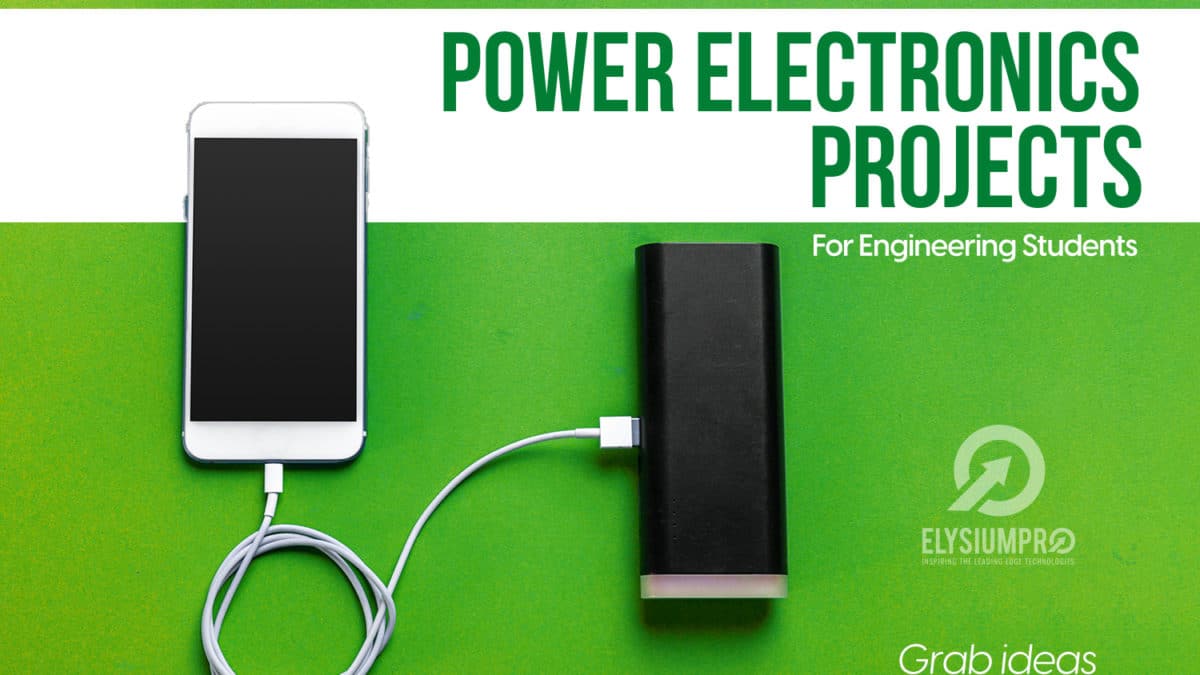- 24/7 Support Center
- +91 9944793398
- 0452 4390702
- info@elysiumpro.in
Power Electronics Based Projects for Final Year Engineering Students

Impact of Internship on Improving Engineering Students
January 22, 2021
3 Wireless Domain Shaping Future Scope of Wireless Networking Projects
November 18, 2022Power Electronics based Projects: Power electronics has become a rapidly developing electrical engineering domain, and this technology covers a wide spectrum of electronic converters. Power electronics deals with controlling the flow of electrical energy- ranked at a power level sooner than a signal level. Its control with the help of solid-state-electronic switches and other control systems. High efficiency, smaller size, lower expense, and lesser weight for converting electrical energy from one form to another are benefits of power electronic devices. In addition, power electronics can convert, figure, and control extensive amounts of power. The application zones of power electronics projects are linear induction motor controls, power system equipment, industrial controlling devices, and so on.
What is Power Electronics Based Projects?
Power Electronics Projects are especially used in Electronics and
Communication Engineering Industry Sector. Content of Power Electronics Projects is to Transform Milli Watts into Mega Watts. Due to improved switching technologies and the demand for more suitable switching circuits, power electronics projects have some essential rules. Providing significant power at high capacity by producing converters of consolidated size and weight is the target of the latest converter technology. The procedure of the electronic knowledge area deals with devices and circuits. The power field does both rotating and inactive equipment.
Essentials tools for power electronics based projects system :
- High reliable.
- Rugged operation.
- Device costs are low.
- Switching fast.
- High current.
- Assembly and repair are simple.
- The frequency is high.
- Low losses.
Classifications of Power Electronics Based Projects
The soundness and response features of closed-loop systems on a successive or sampled data basis are the fields done by the control area.
Power Transmission
- HVAC.
- HVDC.
High-frequency power conversion
- DC/DC, inverters.
Power Grade.
- Harmonic reduction.
- Power factor correction.
- Active filtering.
- Passive filtering.
- Power devices.
- Distributed power systems.
Structure Blocks of Power Electronics Projects
Power-Electronics-Projects
- DC/AC converters.
- AC/AC converters.
- AC/DC converters.
- DC/DC converters.
DC/AC converters
Controllable magnitude and frequency are produced with galvanic isolation via a transformer.
AC/AC converters
Phase, frequency, magnitude and power converters of AC converters with a DC link.
AC/DC converters
Converts AC to DC by adjusting current and voltage.
DC/DC converters
Switching choppers and linear regulations.
Some Latest Power Electronics Projects for Engineering Students
Downward mentioned are some power electronics projects that will benefit electrical and electronics engineering, students. Each final year project defined below can be used for a vast range of applications.
DC-LINK CAPACITOR CURRENT RIPPLE REDUCTION IN DPWM-BASED BACK-TO-BACK CONVERTERS
The dependability of electronic power converters is a significantly essential feature in industrial applications. However, transformation systems operated in the industry are subject to additional stress types, including temperature deviation, oscillation, radiation and humidity. Furthermore, in expansion, the capacitor is the most powerless part in power converters and is responsible for roughly 30% of collapses during power conversion.
A CAPACITOR VOLTAGE-BALANCING METHOD FOR NESTED NEUTRAL POINT CLAMPED (NNPC) INVERTER
A capacitor voltage balancing method for a nested neutral point clamped (NNPC) inverter is presented. The NNPC inverter is a recently formed four-level voltage source inverter (VSI) for medium voltage (MV) applications with effects such as working over a vast range of voltages (2.4-7.2KV) without the essential for clamping power semiconductors in series and high-quality output voltage. The NNPC topology has two flying capacitors in each portion. To confirm the inverter can operate usually and all switching devices transmit exact voltage stress, the voltage across apiece capacitor should be controlled and had at one-third of dc bus voltage. The suggested capacitor voltage balancing method exploits redundancy in phase switching states to control and balance flying capacitor voltages. Uncomplicated and sufficient logic tables are designed for balancing control. The presented method is effortless to implement and requires very few calculations. Moreover, the method is convenient and easy to combine with additional pulse width modulation (PWM) schemes. Simulation and experiment verify the proposed method’s efficacy and feasibility.
SMS Based Electric Billing System Projects:
This SMS established project’s main suggestion is to make an efficient way of circulating electricity bills to consumers by utilizing the remote system with the service of GSM technology as support in the form of an SMS (text messages). As we cause out, automated reading from the electricity meter is one of the future technologies for learning various types of bills via remote application where no human interference is essential.
Similarly, with this technology, an electric billing system based on SMS can be employed to distribute the bills, gaining time, and its working time is fast; however, the physical process is employed for the billing system in the present design. An empowered person will visit every residence and issue a bill based on the reading from the house’s meter. With this process, there is a requirement for a huge amount of human resources.
Power Electronics Enabled Self-X Multi-cell Batteries
A Technique for Smart Batteries: The identical old multi-cell battery method generally uses a preset technique to fix several cells in series and parallel while performing to achieve the necessary voltage and current. However, this assured plan leads to low dependability, error toleration, and non-optimal energy translation significance.
This project proposes a new power electronics-allowed self-X, multi-cell battery device. The projected multi-cell battery will mechanically manage itself with the dynamic load/storage market and the status of each cell. The launched battery can self-repair from a breakdown or unusual function of solo or several cells, self-equilibrium from cell state variations, and self optimizes to reach the best possible energy translation significance.
A new cell switch circuit achieves these options, and a good routine battery management scheme is projected in this project. The project blueprint is established by activating and testing a six-by-three cell polymer lithium-ion battery. The projected approach is common and will be available to any sort or size of battery cells.
Three-Level Boost Converter
This project designs a three-level DC to DC boost converter topology for an increased conversion ratio. This topology contains a fixed boost topology and voltage multiplier. However, this boost converter cannot provide a high boost ratio because it contains a high duty cycle and voltage stress. So, this three-level boost converter provides an always high transformation ratio.
This topology’s main use is improving the output voltage via the diodes and capacitors mixture at the converter output.
This project applies to high power applications by using a severe duty cycle. This converter topology contains capacitors, diodes, inductors & a switch. In addition, this project has formatting parameters like input, output voltage & duty cycle.


